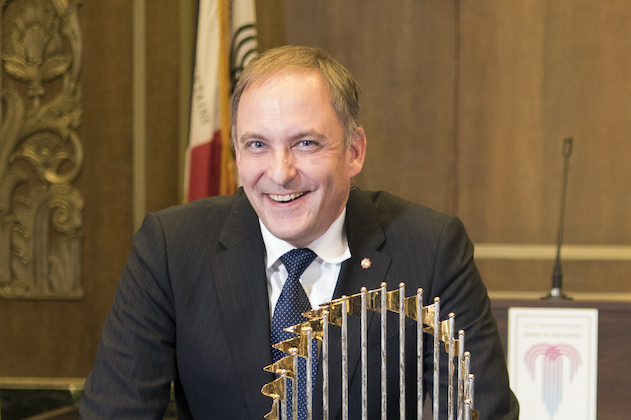
Photo: Screenshot-2019-03-26-at-17.24.24
Playing the civic innovation accordion
26 March 2019
by Jonathan Andrews
By Bob Bennett, Chief Innovation Officer, Kansas City, Missouri
My favourite rock star is eleven years old. Like many parents, we spend ‘quality time’ together driving to and from extra-curricular activities. In his case, this involves guitar lessons at the School of Rock. I usually let him choose the music for the car ride; this gives me a glimpse into what he finds ‘cool’.
Recently, one selection came from Weird Al Yankovic and featured a wicked accordion solo. My first thought: How can Weird Al still be producing music? He and Keith Richards have the longevity thing figured out. My second thought: My job is a less wicked and a much less cool accordion solo.
Civic innovation does not occur at a consistent rate. Civic innovation is not an easily replicable process. In fact, doing civic innovation is kind of like playing an accordion. Have you watched one in action? There is a keyboard, and buttons, and you have to pull and push it just right to make music, which is a metaphor for the civic innovation process.
At its best, a new technology or policy approach moves from ideation to pilot to policy through procurement to scaled deployment in a couple of years with general agreement among stakeholders. This rarely happens. A more common route is ideation to pilot to public outcry to second pilot to cancellation to idea resurrection to second pilot to public input to pivot to third pilot to council review to departmental modification to second public input to fourth pilot to procurement to fifth pilot to scaled deployment after the incumbent system has become hopelessly obsolete and has to be updated due to a crisis.
Just like playing the accordion, city leaders move ideas forward and backward based on public input, city budget or operational capacity and federal or state regulatory guidance. To adjust the tenor of the ideas or policy, a leader makes choices based on the capabilities available in terms of staff, existing processes, equipment or existing physical infrastructure. Which accordion button should she or he push?
The keyboard looks like a piano–very old school–and has to be played by stricter rules. As the policy or tech deployment evolves, the distance between the ideas and city staff ebb and flow like the instrument’s bellows as the player performs the song. At the end of the gig, the policy and city staff is neatly placed back in a carrying case–perhaps a nice metaphor for an ordinance or contract. During the gig, however, it looks like chaos.
Kansas City’s Smart City initiative is a perfect illustration of this dynamic. The first phase public-private partnership involved 14 partners and many public stakeholders. Because both the technology and the data analysis tools were new to the city and deployed concurrently with a transformative capital project (our streetcar), the impact of smart city initiatives remain difficult to isolate or evaluate. From a holistic perspective, downtown Kansas City is a vibrant, connected (digitally and physically) and exciting place to live and work.
The ‘wow’ factor of the KC Streetcar corridor has led to many accolades for the city and continues to impress visitors and residents alike. Shortly after the corridor opened, the city was already leveraging the economic value of the streetcar to justify expanding it. And Kansas City has learned how to combine data derived from sensors deployed in the corridor with other city datasets and third-party data to better understand how to employ city resources or plan future policies.
This led the city to issue its Comprehensive Smart City Request for Proposals (RFP) in June 2018 as a first step to expanding smart city benefits to all 824 square kilometres of Kansas City. That RFP closed in August 2018 and the city’s evaluation team is continuing to look at the proposals submitted in response to it. Because the RFP elements included changes to the way cities evaluate, procure and use technology, the RFP process required four addenda prior to the initial submission of proposals. These addenda allowed the changes in the industry and public expectations to eventually reach an actionable endpoint with city staff. And this journey continues. The city continues to review the proposals and will resolve the RFP in 2019.
We already have some excellent lessons learned from phase one. For example, Avis approached the city with a connected vehicle pilot partnership in November 2017 without defining precisely what was expected from either party. Through iterative experiments, several tools were developed including a strong data sharing understanding, improved traffic assessment algorithms, validation of geofenced enhanced message delivery and identification of many future opportunities for both the private and public sectors.
As partners, we also failed to successfully execute elements that, in hindsight, were likely doomed before we began the experiment. Today our city is better prepared for the evolution to autonomous vehicles because of this pilot, and Avis has a technological advantage in its retail space. A second city partner, Xaqt, developed a new market in the private sector as a result of the partnership.
Kansas City’s Office of Innovation will continue to work in the space between ideas and capacity to solve similarly (un)structured problems, evolving technologies or policy requirements in our city. Our tribe of civic innovators will do the same thing for their communities around the world. Scooters, e-bikes, shared mopeds and other mobility solutions appear on city streets without much pre-coordination. Defining how to implement Missouri’s Amendment 2, which legalises medical marijuana and passed on 6 November 2018, will demand policies quickly because that industry is already well-developed in other states and industry leaders are eager to engage in our market.
The FCC’s preemptive limitations on a city’s capability to operationalise infrastructure required for 5G deployment limit how cities can meet citizen demands for this potentially transformative technology. Given the complexity of these challenges, we are duty-bound to share our ‘sheet music’ to provide some order to what appears to the casual observer as chaos. Despite the crazy gyrations of an accordion, it actually can make some interesting music.








